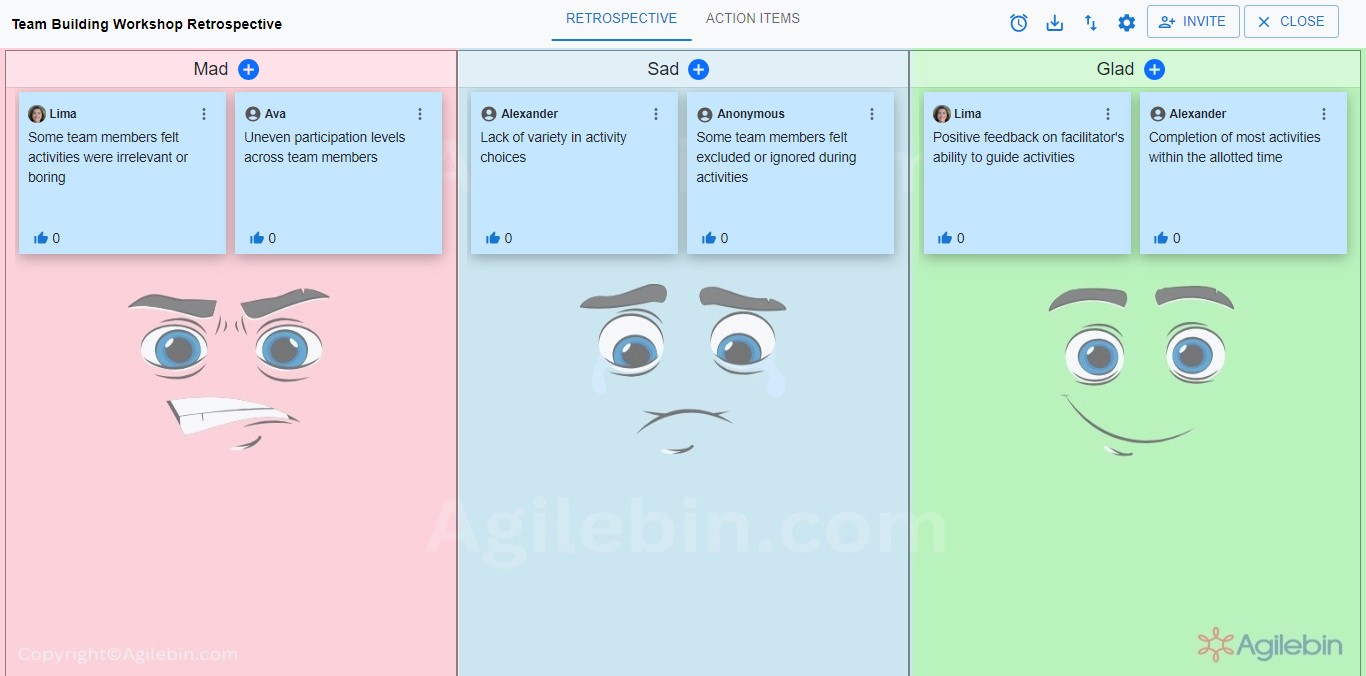Mad Sad Glad Retrospective
Team discusses frustrations, disappointments, and successes for improvement

What is Mad Sad Glad Retrospective?
The Mad Sad Glad retrospective is a valuable practice in Agile methodologies, offering teams a structured opportunity to reflect on their recent endeavors. During these sessions, team members express emotions related to their work experiences, categorizing them into three main categories: mad, sad, and glad. This process promotes open communication and empathy within the team, enabling individuals to share their frustrations, disappointments, and moments of joy. By examining these emotional responses, teams gain valuable insights into areas for improvement, celebrate successes, and strengthen their collaboration moving forward.
How to Run Mad Sad Glad Retrospective?
To run a Mad Sad Glad Retrospective, follow these steps
- Preparation: Schedule a time for the retrospective, inform team members, and set up the environment.
- Introduction: Explain the purpose and rules of the retrospective.
- Generate Ideas: Provide sticky notes for team members to write down their thoughts.
- Sharing: Invite team members to share their thoughts in each category (mad, sad, glad).
- Grouping and Clustering: Group similar notes together and identify common themes.
- Discussion: Facilitate a discussion around each category and explore root causes and solutions.
- Action Planning: Identify actionable items for improvement and assign ownership.
- Closure: Summarize key takeaways and thank everyone for their participation.
- Follow-up: Monitor progress on action items and incorporate feedback into future iterations.
- Iterate: Continuously refine the retrospective process based on team feedback.
Columns in Mad Sad Glad Retrospective
Typically, the retrospective is divided into three columns:
- Mad: This column is dedicated to aspects that provoked frustration or annoyance among team members. This can encompass a range of issues including unresolved conflicts, lack of communication, unmet expectations, or external disruptions. It's where team members highlight obstacles that impeded progress and caused stress or dissatisfaction.
- Sad: In the Sad column, team members express feelings of disappointment, regret, or sadness regarding the project or sprint. This might include instances of failure, missed deadlines, scope creep, quality issues, or instances where the team fell short of expectations. It's a space for acknowledging setbacks and recognizing areas where improvement is needed.
- Glad: This column is reserved for celebrating successes, achievements, and positive developments that occurred during the project or sprint. It's where team members highlight moments of collaboration, breakthroughs, successful deliveries, and any other aspects that contributed to a sense of accomplishment or satisfaction. It's important for fostering morale and recognizing the efforts that led to positive outcomes.
When to do a Mad Sad Glad Retrospective
The Mad Sad Glad retrospective is typically conducted at the end of a project iteration or sprint in agile or Scrum methodologies. It's an essential part of the iterative process, providing an opportunity for teams to reflect on their performance, identify areas for improvement, and celebrate successes.
Here are some common scenarios in which teams might choose to conduct a Mad Sad Glad retrospective:
- End of Sprint/Iteration: Conducting the retrospective at the end of each sprint or iteration allows teams to review their progress, assess what went well, what didn't, and what could be improved before moving on to the next phase.
- Milestone Completion: Teams may also conduct a retrospective at the completion of a significant milestone within a project. This could be after the completion of a specific feature, module, or phase, providing an opportunity to reflect on the overall progress and make necessary adjustments for future work.
- Project Completion: When a project comes to an end, either successfully or otherwise, it's important to conduct a retrospective to capture lessons learned and gather insights for future projects. This retrospective may take a broader view, reflecting on the project as a whole rather than specific iterations.
- After Significant Events or Issues: Teams may choose to conduct a retrospective in response to significant events or issues that occurred during the project. This could include major setbacks, conflicts within the team, or unexpected challenges. Reflecting on these events helps teams understand their causes and develop strategies to prevent similar issues in the future.
How can you conduct a Mad Sad Glad retrospective with Agilebin?
Effortlessly conduct a Mad Sad Glad retrospective with Agilebin's ready-to-use template!
Why Agilebin's template? Because it provides a realistic and immersive experience, making your Mad Sad Glad retrospective feel authentic and meaningful. With Agilebin's ready-to-use template, you'll feel like you're navigating through the actual process, allowing for a more effective and insightful retrospective session.
Choose Mad Sad Glad retrospective template in Agilebin
Choose the Mad Sad Glad Retrospective template from Agilebin's collection of retrospective templates. This template is specifically designed to facilitate the Mad Sad Glad Retrospective process, providing a structured framework for your team's reflection and improvement discussions
Invite team members to participate in the retrospective session
Invite team members to participate in the retrospective session by adding their email addresses or sharing the session link directly with them. You can choose between public access using a link, allowing anyone with the link to join, or restricted access, limiting participation to specific users or teams.

Facilitate Discussion with Sticky Notes
Agilebin offers pre-defined columns for the Mad Sad Glad Retrospective, including 'Mad', 'Sad', 'Glad'. Participants can add sticky notes to each column during the retrospective session, sharing their feedback, observations, and suggestions
